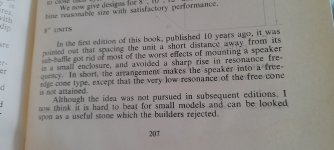It’s the same construction but bigger. So it’s about 50g. 912 cm versus 500 cm2.I just checked, 10g is 2 A4 printer paper. 26g is just 5 A4 paper. Is your 2nd project panel that light too?
It’s calculated from
Balsa 100kg /m3
The carbon fibre is 80g/m2, laminated with epoxy it’s 140 g /m2, I’ve assumed 160 g/m2.
I might have underestimated the amount of epoxy being used.
Small panel 26g and the larger panel 50 g.Hat was the finished weight of the panel? Thanks
And, your placement of 6 exciters is not according to any patent. 🙂It’s the same construction but bigger. So it’s about 50g. 912 cm versus 500 cm2.
It’s calculated from
Balsa 100kg /m3
The carbon fibre is 80g/m2, laminated with epoxy it’s 140 g /m2, I’ve assumed 160 g/m2.
I might have underestimated the amount of epoxy being used.
Very glad you joined this forum.
Last edited:
Sandasnickaren, you have made a great job!Small panel 26g and the larger panel 50 g.
Which exciters do you use in the 6 exciter model?
Thanks.I do it one step. I’m using a slow setting epoxy which gives me 4 hours to complete the bagging. Yes, I’m using glass plate on the front side.
I’m planning to , in future, laminate the carbon skins separately and then in the final step combine them with the balsa core. The resaon for this is to minimize the amount of epoxy penetrating the balsa. My understanding of the requirements on the panel is to have as stiff skins as possible and as low density in the panel as possible (I might be wrong here…).
I have tried laminates with softer skins ricepaper, silk and glass fibre none of them had a decent frequency response above 10Khz.
Check out the textreme carbon fibre it has some unique properties.
Concerning the goal of stiff and light, I think you are 100% correct, at least with respect to efficiency. And "light" is even more important than "stiff", so yes, minimizing excess epoxy (weight) is a worthy goal. But I don't think it will make the panels sound any better other than to make them louder. So if you are already satisfied with how loud they are, then it may not be worth a great deal of extra effort to further minimize the weight.
That said, one method of minimizing epoxy weight (possibly), is to drill an array of holes in the balsa. Then you can do your "one step" process and still (theoretically) pull excess epoxy out of both carbon skins. Too bad I learned about this method only after I had made my carbon panels! I did try it out on the two panels pictured below. The first is fiberglass/balsa and the second is fiberglass/divinylcell foam. This method seemed to work pretty well, although I can't say for sure it works better than any other way. This is probably the method I'll use if I do another set of carbon/balsa panels.
I also tried some methods to seal the balsa (i.e pore fill), but the things I tried added weight of their own, and I ended up at about the same final weight, and a more complex and time consuming process. So I gave up on that route, at least for now.
My main carbon supplier does carry the Textreme. It does look good. The spreadtow that I used was the Hexcel Primetex, which seems to have the same features (for a bit less $$), but there may be something I'm missing. I noticed they have a Textreme 60g High Modulus spreadtow that might be really great option, but for about twice the price of the 80g standard modulus. If only I had unlimited time and money to try them all!
Eric
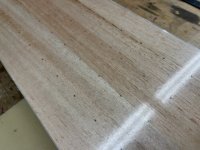
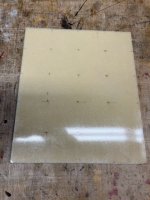
@StimperLooks like Aliexpress has. Hope it helps.
Did you see any "end grain" balsa there (I didn't). Model airplane suppliers sell balsa down to 0.8 mm, but usually it's not end grain.
End grain balsa has the greatest stiffness/strength in the thickness direction, as that's the direction of the grain. Presumably that's why Goebel chose it for his panels.
Neither Sandasnickeran (based on the photos he shared) nor I, used end grain balsa. I previously never found any of an appropriate thickness. But I think the results can be pretty good even without end grain balsa.
Today I did find end grain balsa here, but it's pretty pricey. And apparently there's an extra cost if you want to specify a particular density range!
https://specializedbalsa.com/products/end_grain.php
Eric
And the winner is....
As others have said, awesome job. Very nice.
The infinite baffle can't hurt!
Eric
And I thought the frames I built were stiff!measurements from 1m and nearfield few cm.
Sorry for the barrage of questions, but it's to be expected, with such a great job.
Can you clarify about the two spl measurements, which is the nearfield and which is the far? Any dsp in either? The last one is so remarkably flat up to almost 2kHz, and nothing like anything I've ever measured, so I'm curious which measurement that is. But this is a BMR, not pure DML, so wouldn't be familiar to me.
I recall that for piston speakers, nearfield measurements can help to minimize room effects (isn't that right?). But for pure DML, nearfield can be very tricky. Since the panel response varies drastically from point to point, nearfield measures are very dependent on exactly what part of the panel the speaker is closest to. I've found that (very) nearfield measurements are great for modal analysis, for example, as they can differentiate easily between nodes and antinodes of the various modal frequencies.
I'm wondering if the measurement that's so "pistonic" flat up to nearly 2k, but DML "bumpy" above 2KHz is an indication of where the panel transitions from pistonic to DML. What do you think? Or is there another explanation. What do you think?
In an earlier post you mentioned "windowing". I'm an REW novice, and never felt confident with how to adjust REW windowing settings. I use the REW defaults (I think!). But always wonder if they are appropriate for DML speakers, any thoughts on that would be appreciated.
Eric
This concept goes back (at least) to this patent by Heron, which was he precursor to the NXT patents, I believe. But I think others like Bertagni were aware of it earlier.So, the lightness of the panel is the most important factor, other than how it is made - a composite. 🙂
https://patentimages.storage.googleapis.com/9a/43/32/b09245ff903cac/WO1992003024A1.pdf
Eric
Thanks Eric,@Stimper
Did you see any "end grain" balsa there (I didn't). Model airplane suppliers sell balsa down to 0.8 mm, but usually it's not end grain.
End grain balsa has the greatest stiffness/strength in the thickness direction, as that's the direction of the grain. Presumably that's why Goebel chose it for his panels.
Neither Sandasnickeran (based on the photos he shared) nor I, used end grain balsa. I previously never found any of an appropriate thickness. But I think the results can be pretty good even without end grain balsa.
Today I did find end grain balsa here, but it's pretty pricey. And apparently there's an extra cost if you want to specify a particular density range!
https://specializedbalsa.com/products/end_grain.php
Eric
I will contact them for a price, will see how much shipping to the UK adds.
In the mean time, I will order up some balsa sheets and glue them together.
I have some spread tow carbon left over, so will experiment with that and might also buy a tub of carbon powder to try it with just an epoxy coating. This won’t cost too much, and I’ll see how I get on with cf skins on balsa too with what I have, or it could be an expensive mistake! 🤣. Shame I only have 160g spread tow, they didn’t sell the 88g version or I would have got that at the time.at least I can practice to get a smoother surface finish, as last time I made a spread tow single sheet it didn't come out too well.
The concept of lightness goes back to 1922, I suppose to Robert Marriott, Georg Graf von Arco and even to people before him, like the drum makers of the ancient times. Anyway, the most important factor is the lightness of the membrane, and that it is a composite -- the way the sound travels in different materials, and the way certain type of damping happening within those, and the stiffness in different directions, opposing to each other. Usually, a composite panel works quite differently to its components, an example is the SIP panels in building construction.This concept goes back (at least) to this patent by Heron, which was he precursor to the NXT patents, I believe. But I think others like Bertagni were aware of it earlier.
Eric
By the way, on the question of pore filling, you have to spray that on. Göbel mentions that it could be ~2g. The idea here is not to let the epoxy going into the main membrane, balsa, and changing its parameters. This matter is also mentioned in Herger's patents. (By the way, I'm glad that @Sandasnickaren joined this thread because of those "Russian patents" #8,070 ).
On the matter of lightness of the membrane, paper cone in standard speaker drivers, mylar in planar types, bypassing the 'coil former' in some way - eliminating that with chemicals under the very thin aluminium flat printed coil, pasted to mylar with spray glue, etc.
@Sandasnickaren latest project is quite high WAF, by the way! 🙂
For the cover film, I suppose, we can use car wraps,
The foil has a micro-channel adhesive that facilitates the removal of air bubbles during application, making the application easier and faster compared to foil with ordinary glue. The film is thermoplastic, ideal for external use - wrapping entire cars, as well as internal use as decorative elements of the cockpit, dashboard, etc. The film uses a strong self-adhesive adhesive, which is secured by a layer of backing paper.
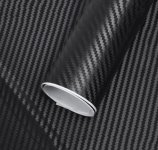 ~3.5EUR per 50cm x 152cm roll.
~3.5EUR per 50cm x 152cm roll. Or, shiny foil for about 6EUR
Or, shiny foil for about 6EUR
Last edited:
From G A Briggs book.
This short section on mounting a speaker drive unit to a cabinet without the need for a port could easily be adapted for a free edged panel Or even a lightly mounted panel that allows air movement from the side gaps.
Although of course, you would loose the rear radiation from the panel.
Ps.
Probably something BMR users might want to try.
I used this method many years ago in my very small 2" coned surround sound speakers to good effect.
Steve.
This short section on mounting a speaker drive unit to a cabinet without the need for a port could easily be adapted for a free edged panel Or even a lightly mounted panel that allows air movement from the side gaps.
Although of course, you would loose the rear radiation from the panel.
Ps.
Probably something BMR users might want to try.
I used this method many years ago in my very small 2" coned surround sound speakers to good effect.
Steve.
Attachments
A 3 layer composite of lime wood and balsa is available at hobby shops, 3mm x 245mm x 495mm, with lime wood sandwiching the balsa wood, used for making aircraft flying models. Wikipedia says, that Lime wood is generally 560kg/m3, though. I sent an email asking about the weight of that panel. Most probably will get a reply on Monday, today being a holiday. I can plane it down, if that is too heavy. 🙂
I should point out that I placed spacers between the cabinet and the speaker so that the rear of the driver was firing into the box and not mounted hard up to the box or behind it.
This gave a very free natural sounding midrange free from the usual boxy sound .
Steve.
This gave a very free natural sounding midrange free from the usual boxy sound .
Steve.
Part of what gives DML's there unique sound signature is that the rear/back of the panels radiates sound. Take that away and the sound drastically changes.
Last edited:
Actually, thinking about it ,I might have used the method in the second picture for first testing 8" drivers
Except instead of the mounting the driver on the back of the speaker baffle, I mounted it on the front.
I Basically just turned the drive unit around so that the magnet was on the outside of the speaker.
While not ideal, it did allow me to test the theory easily with spacers ,to get the right spacing.
Although with my small surround speakers the xo was quite high , but the sound improved so much that I could actually listen to music on them without being annoyed 😁
Steve.
Except instead of the mounting the driver on the back of the speaker baffle, I mounted it on the front.
I Basically just turned the drive unit around so that the magnet was on the outside of the speaker.
While not ideal, it did allow me to test the theory easily with spacers ,to get the right spacing.
Although with my small surround speakers the xo was quite high , but the sound improved so much that I could actually listen to music on them without being annoyed 😁
Steve.
This concept goes back (at least) to this patent by Heron, which was he precursor to the NXT patents, I believe. But I think others like Bertagni were aware of it earlier.
https://patentimages.storage.googleapis.com/9a/43/32/b09245ff903cac/WO1992003024A1.pdf
Eric
View attachment 1126847
No dsp.And I thought the frames I built were stiff!
Sorry for the barrage of questions, but it's to be expected, with such a great job.
Can you clarify about the two spl measurements, which is the nearfield and which is the far? Any dsp in either? The last one is so remarkably flat up to almost 2kHz, and nothing like anything I've ever measured, so I'm curious which measurement that is. But this is a BMR, not pure DML, so wouldn't be familiar to me.
I recall that for piston speakers, nearfield measurements can help to minimize room effects (isn't that right?). But for pure DML, nearfield can be very tricky. Since the panel response varies drastically from point to point, nearfield measures are very dependent on exactly what part of the panel the speaker is closest to. I've found that (very) nearfield measurements are great for modal analysis, for example, as they can differentiate easily between nodes and antinodes of the various modal frequencies.
I'm wondering if the measurement that's so "pistonic" flat up to nearly 2k, but DML "bumpy" above 2KHz is an indication of where the panel transitions from pistonic to DML. What do you think? Or is there another explanation. What do you think?
In an earlier post you mentioned "windowing". I'm an REW novice, and never felt confident with how to adjust REW windowing settings. I use the REW defaults (I think!). But always wonder if they are appropriate for DML speakers, any thoughts on that would be appreciated.
Eric
The first two are from 1m . The measurement with a very straight respons is nearfield. you should view them as indicative… I agree that the straight line looks suspicious It’s simply to good…
I will do new measurement, to verify.
Yes, the nearfield measurements are mainly useful up to maybe 1Khz depending of the size of the driver.
The coincidence frequency is around 250 Hz based on the response from the smaller panel which only operates as dml/bending wave. I think the bumps in the response is room influences to some extent And possibly from the fact that they are operating in a ” Box” the wall.
Yes my experience is that it’s really hard to measure omni directional speakers in a room. I prefer to measure them outdoors.
Thomas
No it’s a new innovation😉And, your placement of 6 exciters is not according to any patent. 🙂
Very glad you joined this forum.
The reason for placing them like this is the Piston mode. It was the only way I could think of to achieve symetrical drive of the panel.
I dont know if there is any penalty in the dml mode? It doesnt seem to, considering the frequency response and distorsion. Maybe some of the wiggles in the frequency respons are due to this. But I wont know before I remove the speakers from the wall and measure them outdoors.
Well, you are going to use them indoors, so the measurements are not the most important matter, but how it sounds to you, and your wife/partner. 🙂No it’s a new innovation😉
The reason for placing them like this is the Piston mode. It was the only way I could think of to achieve symetrical drive of the panel.
I dont know if there is any penalty in the dml mode? It doesnt seem to, considering the frequency response and distorsion. Maybe some of the wiggles in the frequency respons are due to this. But I wont know before I remove the speakers from the wall and measure them outdoors.
What's interesting is, the transverse waves made by 6 sources at the same time are fighting each other on the same plane and still gives nice output. At what distances, they are placed on the panel? Have you put a rubber puck inside the bobbin/coil-former under the exciter? Do you have the angled lines/cuts on the perimeter of the panel as Gobel's? If so, at what angles, at what distances?
You've left the edges free,
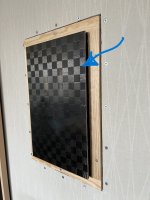 Is it because it acts more like a BMR?
Is it because it acts more like a BMR?
Last edited:
- Home
- Loudspeakers
- Full Range
- A Study of DMLs as a Full Range Speaker
